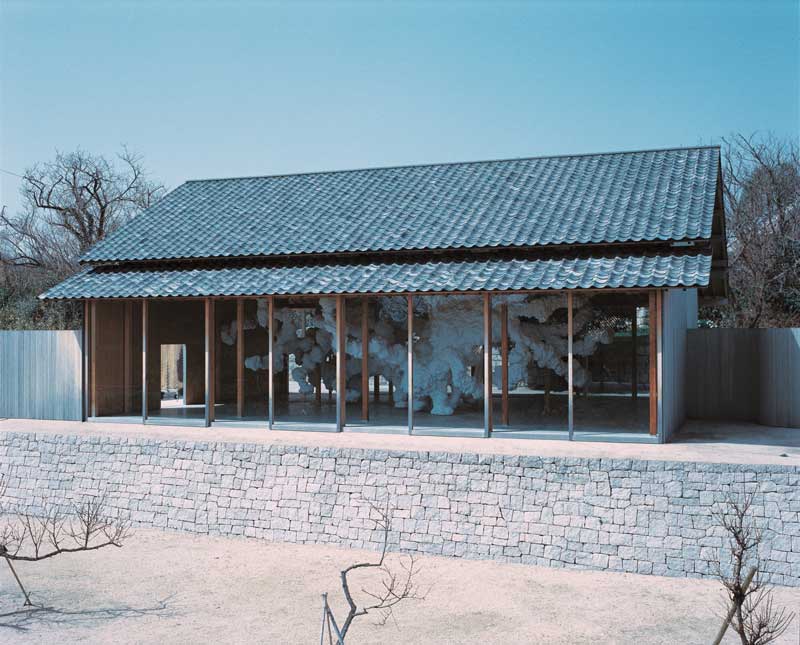
White, cloud-like forms delicately float beneath the wooden beams of a traditional house. Translucent panels with bright yellow, magenta, and blue geometric patterns form a pavilion amidst tiled roofs, with palm trees in the background. The shining silver façade of a miniature bar is surrounded by wildflowers. All these surprising sights and more can be found on Inujima, a small, lush island located in Japan’s Seto Inland Sea. The island can be walked across on foot in an hour, and it’s currently home to only 25 households – more than half of the residents are over the age of 70 years. Once a hub for granite quarrying and copper refining, in recent decades the island has faced the same concerning trend of many former industrial and rural areas across the country – depopulation as younger people leave for better opportunities elsewhere, leaving behind only the elderly. But Inujima has undergone a dramatic revitalization through culture, thanks to the Inujima “Art House Project”. This innovative initiative has transformed the island into a hub of contemporary art and culture, attracting visitors from around the world, and is the subject of JAPAN HOUSE Los Angeles’ latest exhibition “Symbiosis: Living Island” (Apr 15-July 5, 2023).
There are other “art islands” in Japan that are major tourism destinations, like the famed Naoshima island, the home of Benesse Art Site Naoshima which began in the early 1990s, and over the years has become known for its museums and displays of high-profile art stars from Claude Monet to Yayoi Kusama. Since then, several other islands have established art and cultural projects, including Inujima, which became one of the sites of the Benesse Art Site Naoshima (projects supported by Benesse Holdings Inc., and Fukutake Foundation) in 2008. But though it’s only a 55-minute ferry ride from Naoshima, activities on Inujima have had a slightly different approach from the start, emphasizing gentle symbiosis over spectacle.

*To watch the video in full screen, please click on the image above, then click on the YouTube icon on the lower right-hand corner.
The Inujima “Art House Project” was developed in collaboration between curator Yuko Hasegawa (Director of the 21st Century Museum, Kanazawa) and Kazuyo Sejima, Pritzker Prize-winning architect and founding partner of the firm SANAA, who felt that the project should evolve in response to the island itself. They embarked on a phase-by-phase process, first creating a series of galleries around the island that were largely constructed in restored and adapted old houses, each with its own garden to blur the boundary between inside and outside, and each hosting the works of artists invited by Hasegawa who crafted their work sustainably (often with recycled materials) and with the residents in mind. By interweaving the art project with the existing landscape and community, it transformed the villages themselves into a sort of living “museum” that can be activated in different ways by the paths taken through it by local residents and visitors alike. Kazuyo Sejima & Associates has referred to this as a type of “architectural acupuncture”.

Inujima “Art House Project” F-Art House at Inujima Island | Photo by Takashi Homma, Courtesy of Fukutake Foundation

Inujima “Art House Project” F-Art House at JAPAN HOUSE Los Angeles' Symbiosis: Living Island exhibition
Visitors will be captivated by installations by world-class artists, including multidisciplinary Japanese artist Kohei Nawa, whose “Biota (Fauna / Flora)” is a cloud of white forms inside a traditional house. Brazilian artist Beatriz Milhazes’ “Yellow Fever Dream”, is a dazzling, colorful translucent outdoor pavilion, while Icelandic-Danish artist Olafur Eliasso’s set of mirrors called “Self-loop” invites reflection of all sorts, and Japan’s Masanori Handa’s “Flowers” adds a sense of fantasy to the natural landscape. Many of these works have been captured by the renowned photographer Takashi Homma, who shows how smoothly the works have been integrated into the natural and village landscape. And it’s this last aspect that may best illustrate Inujima’s unique character – it's *more* than the sum of its parts; the island is an artwork in itself.
Over time, this quality has been enhanced by the project’s additions of amenities like a botanical garden (centered on an abandoned glass greenhouse), a bar, a kitchen, and lodgings that made it easier for visitors to stay and experience the island over multiple days.


The popular “Hoppy Bar” is a small bar opened in a renovated house in partnership with the Hoppy spirits company, serving alcoholic beverages as well as light meals. The bar (which is featured in the “Symbiosis” exhibition) boasts a unique design that blends outdoors and indoors and was constructed with such elements as Inujima-quarried stone and seashells. For more dining attractions, there’s also a café at the Seirensho Art Museum that spotlights favorite local dishes like Tako-meshi (Octopus rice) and Inujima-zenzai (red bean soup).

There have also been educational programs focused on community and environmentalism, inviting international students to workshops to learn about the island, practice bamboo forest management or aid in plans for a community kitchen. Unlike some other art tourism spots, where cultural pilgrims drop in for a day or two, Inujima welcomes encourages longer stays so that guests can fully immerse themselves in the pace, the lifestyle, the conversations, and these ongoing initiatives that can only be experienced by slowing down. There are a surprising number of additional things to do on this small island, including other art interventions (like the “Seierensho Art Museum” designed by architect Hiroshi Sambuishi, housed in a re-furbished copper refinery), as well as shrines, temples and spaces to absorb and contemplate nature. Surrounded by glittering waters, Inujima is also home to superb seafood, adding another delicious dimension to the various culinary experiments on the island.
Not only a burgeoning destination for the thoughtful art traveler, Injujima is also a case study in how to revitalize rural spaces through sustainable, adaptive reuse and collaboration with local communities – a lesson that could have far-rippling inspirations. As the curator Hasegawa explains, the term “symbiosis” has a slightly different meaning in the West – where it primarily refers to humans helping each other. But in Japan, the word has a farther-reaching connotation of a web that connects all things, not just plants and animals, but also objects: “everything we interact with, all the things around us exist side by side and support each other.” Inujima embraces this principle as a guiding ethos, a deeply connected interdependence between all living creatures and the landscape of the island itself, along with the animating energy of art, creativity, and learning.

